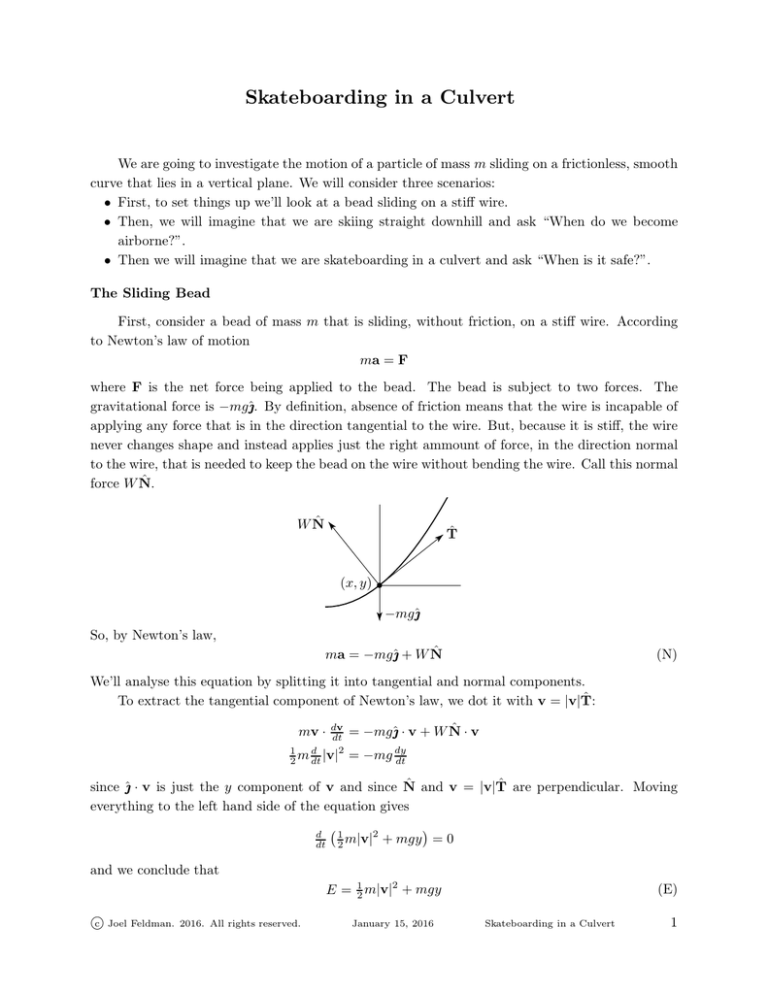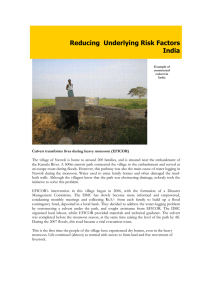Skateboarding in a Culvert
advertisement

Skateboarding in a Culvert We are going to investigate the motion of a particle of mass m sliding on a frictionless, smooth curve that lies in a vertical plane. We will consider three scenarios: • First, to set things up we’ll look at a bead sliding on a stiff wire. • Then, we will imagine that we are skiing straight downhill and ask “When do we become airborne?”. • Then we will imagine that we are skateboarding in a culvert and ask “When is it safe?”. The Sliding Bead First, consider a bead of mass m that is sliding, without friction, on a stiff wire. According to Newton’s law of motion ma = F where F is the net force being applied to the bead. The bead is subject to two forces. The gravitational force is −mĝ. By definition, absence of friction means that the wire is incapable of applying any force that is in the direction tangential to the wire. But, because it is stiff, the wire never changes shape and instead applies just the right ammount of force, in the direction normal to the wire, that is needed to keep the bead on the wire without bending the wire. Call this normal force W N̂. W N̂ T̂ (x, y) −mĝ So, by Newton’s law, ma = −mĝ + W N̂ (N) We’ll analyse this equation by splitting it into tangential and normal components. To extract the tangential component of Newton’s law, we dot it with v = |v|T̂: mv · dv dt 2 d 1 m dt |v| 2 = −mĝ · v + W N̂ · v = −mg dy dt since ̂ · v is just the y component of v and since N̂ and v = |v|T̂ are perpendicular. Moving everything to the left hand side of the equation gives d dt 1 m|v|2 2 + mgy = 0 and we conclude that E = 12 m|v|2 + mgy c Joel Feldman. 2016. All rights reserved. January 15, 2016 (E) Skateboarding in a Culvert 1 is a constant, qindependent of time. This is, of course, conservation of energy. It determines the − 2gy of the bead as a function of the height y (and of the energy E, which is speed |v| = 2E m determined by the initial conditions). To extract the normal component of Newton’s law, (N), we dot it with N̂: ma · N̂ = −mĝ · N̂ + W Since a(t) = d2 s dt2 T̂ + κ ds 2 N̂ dt = d2 s dt2 T̂ + κ|v|2 N̂ and T̂ and N̂ are perpendicular, this gives W = mκ|v|2 + mĝ · N̂ = 2κ(E − mgy) + mĝ · N̂ (W) The Skier The difference between the bead on the wire and the skier on the hill is that while the hill is capable of applying an upward normal force (i.e. it can push you upward to keep you from falling to the centre of the Earth), it is not capable of applying a downward normal force. That is the hill cannot pull down on you to keep you on the hill. There are two main possibilities. N̂ T̂ N̂ T̂ • If the hill is convex downward as in the figure on the right, then N̂ points downward and the hill is allowed to have W ≤ 0 (which corresponds to the normal force W N̂ pushing upward). If ever W > 0, the hill would have to pull on you to keep you on hill. It can’t, so you become airborne. Since ̂ · N̂ < 0, this happens whenever 2 W > 0 ⇐⇒ mκ|v| + mĝ · N̂ > 0 ⇐⇒ |v| > q g · κ |̂ N̂| • If the hill is convex upward as in the figure on the left, then N̂ points upward and the hill is allowed to have W ≥ 0 (which corresponds to the normal force W N̂ pushing upward). Since ̂ · N̂ > 0 we always have W = mκ|v|2 + mĝ · N̂ > 0. You never become airborne. The Skate Boarder So far, equations (E,W) apply to any stiff frictionless “wire”. We now specialize to the special case of a skateboarder inside a circular culvert of radius a. Let’s put the bottom of the circle at the origin (0, 0), so that the centre of the circle is at (0, a). c Joel Feldman. 2016. All rights reserved. January 15, 2016 Skateboarding in a Culvert 2 a − y φ aN̂ (x, y) In this case the curvature is κ = |v| = q 1 a 2 (E m and ̂ · N̂ = cos φ = − mgy) = W = a2 (E − mgy) + q 2g mg a (a E mg a−y a −y − y) = so (E) and (W) simplify to (E) 3mg 2 a ( 3mg E + a 3 − y) (W) Imagine now that you start at the bottom of the culvert, that is at y = 0, with energy E > 0. As time progresses, y increases and consequently |v| and W both decrease. This continues until one of the following three things happen (i) |v| hits 0, in which case you stop rising and start descending. The speed |v| is zero when E y = yS = mg . (The subscript “S” stands for “stop”.) (ii) W hits zero. When you get higher than this, W becomes negative and the culvert would have to pull on you to keep your feet on the culvert. As the culvert can only push on you, you E + a3 . (The subscript “A” become airborne. The normal force W is zero when y = yA = 23 mg stands for “airborne”.) (iii) y hits 2a. This is the summit of the culvert. You descend on the other side. Which case actually happens is determined by the relative sizes of yS , yA and 2a. E E E E ◦ Comparing yS = 32 mg + 13 mg and yA = 23 mg + a3 , we see that yS ≤ yA ⇐⇒ mg ≤ a. ◦ Comparing yA = ◦ Comparing yA = 2 3 2 3 E mg E mg + + a 3 a 3 and 2a = 53 a + a3 , we see that yA ≤ 2a ⇐⇒ and a = 23 a + a3 , we see that yA ≤ a ⇐⇒ E mg E mg ≤ 52 a. ≤ a. So the conclusions are: E ≤ a then 0 ≤ yS ≤ yA ≤ a . In this case you just oscillate between heights 0 and ◦ If 0 ≤ mg yS ≤ a in the bottom half of the culvert. E ≤ 52 a then a ≤ yA ≤ yS , 2a . In this case you make it more than half way to ◦ If a ≤ mg the top. But you become airborne at y = yA which is somewhere between the half way mark y = a and the top y = 2a. At this point our model breaks down because you are no longer in contact with the culvert. You just free fall in a parabolic arc until you crash back into the culvert. E ◦ If 52 a < mg then 2a < yA < yS . In this case you successfully go all the way around the culvert, looping the loop. c Joel Feldman. 2016. All rights reserved. January 15, 2016 Skateboarding in a Culvert 3







